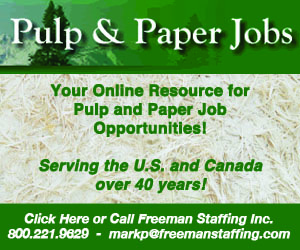Career Opportunities
|
Rayonier Advanced Materials Jesup, Georgia
Visit http://careers.tappi.org/jobs/8007275/scientist to view the full article online. |
|
Enzymatic Deinking Technologies LLC Norcross, Georgia
Visit http://careers.tappi.org/jobs/8025568/r-d-chemist to view the full article online. |
|
TAPPI Peachtree Corners, Georgia
Visit http://careers.tappi.org/jobs/8030755/tappisafe-content-manager to view the full article online. |
|
Rayonier Advanced Materials Jesup, Georgia
Visit http://careers.tappi.org/jobs/8056964/industrial-engineer to view the full article online. |
Industry Outlook
|
Transparency Market Research, Albany, N.Y., USA, has published a new market report titled Paperboard Packaging Market - Global Industry Analysis, Size, Share, Growth, Trends and Forecast 2016 – 2024. According to the report, the paperboard packaging market was valued at $122.69 billion in 2015 and is likely to reach $227.47 billion by 2024, expanding at a CAGR of 7.1% between 2016 and 2024.
Paperboards are manufactured from wood pulp or layers of paper. The thickness of paper plies defines the paperboard, which is usually larger compared with paper to maintain the weight to area ratio. For instance, according to the International Organization for Standardization, the weight should be 224 gsm to consider it as paperboard. Depending on application, paperboard can be single ply or multi-ply. Paperboard offers good printing surface and excellent print quality, which makes it ideal information carriers and brand builders. Approximately 70% of paperboards are recycled, making these ideal for sustainable packaging compared with plastics, metals, and glasses.
The global paperboard packaging market can be segmented into product type such as boxboard and containerboard. Boxboard includes folding, kraft, and laminated boxboards. Depending on the grade and processing of the boxboard, it can be further sub-segmented into folding boxboard (FBB), solid unbleached boxboard (SUB), solid bleached boxboard (SBB), and white lined chipboard (WLC). Demand for WLC was the highest compared with other boxboards in 2015.
Containerboard includes corrugated containerboard and linerboard. In terms of volume, containerboards was the majorly used type of paperboard across the globe in 2015. The market for containerboard is estimated to increase significantly during the forecast period due to high demand from applications in regions such as Asia Pacific and Latin America. Based on application, the global paperboard packaging market can be segmented into food and beverages, non-durable goods, durable goods, medical, and others. The others segment includes industrial and machineries packaging.
A free research PDF for more professional and technical insights is available online.
|
|
Pulpwood costs have fallen substantially worldwide with the softwood and hardwood pulpwood price indices in the 4Q/15 being at their lowest levels in more than 10 years, reports the Wood Resource Quarterly (WRQ), Seattle, Wash., USA.
Wood cost is the factor that often determines the competitiveness of a pulp manufacturing plant or region because it is the largest cost component when producing wood pulp, WRQ notes. During the past few years, this cost has varied between 45% and 70% of the total cash cost, depending on product grade and the costs of other components such as chemicals, energy, and labor.
Hardwood fiber prices continued to fall in most of the major pulp-producing countries in the world in the 4Q/15. The biggest declines were seen in Brazil, Chile, Russia, France, Germany, and Indonesia. In most regions, the price adjustments occurred in both local currencies and in U.S. dollar terms. The hardwood price index (HFPI) fell more than 2% from 3Q/15 to a level that was almost 10% lower than in the 4Q/14.
Russian pulp mills have substantially lower wood fiber costs than most competitors around the world thanks to the weak Ruble. Prices for hardwood pulp logs were less than half of the average prices in Brazil and Chile in the 4Q/15, according to the latest issue of WRQ. In U.S. dollar terms, current price levels are also half of what they were two years ago. Pulp log prices throughout Europe have also fallen quite substantially the past few years but remain among the highest in the world.
With the exception of the U.S. South and New Zealand, softwood fiber prices were also down throughout the world in the 4Q/15. The declines ranged between 2% to 10% from the previous quarter. The softwood price index (SFPI) was $88.46/odmt, a reduction of 1.4% from the previous quarter and 7.5% lower than the same quarter in 2014. Both the SFPI and HFPI are currently at the lowest levels in more than 10 years.
The Global Wood Fiber Price Index is a weighted average of delivered wood fiber prices for the pulp industry in all regions tracked by WRQ. These regions together account for 85%-90% of the world’s wood-based pulp production capacity. The price is based on current quarter average prices, and country/regional wood fiber consumption data. The global average price for softwood and hardwood is calculated in nominal U.S. dollars per oven-dried metric ton of wood fiber.
|
Get Social
|
Follow TAPPI on Facebook, Twitter and LinkedIn to stay up to date on association news and industry trends. Also, join in the TAPPI Community to discuss topics with other member professionals. |

